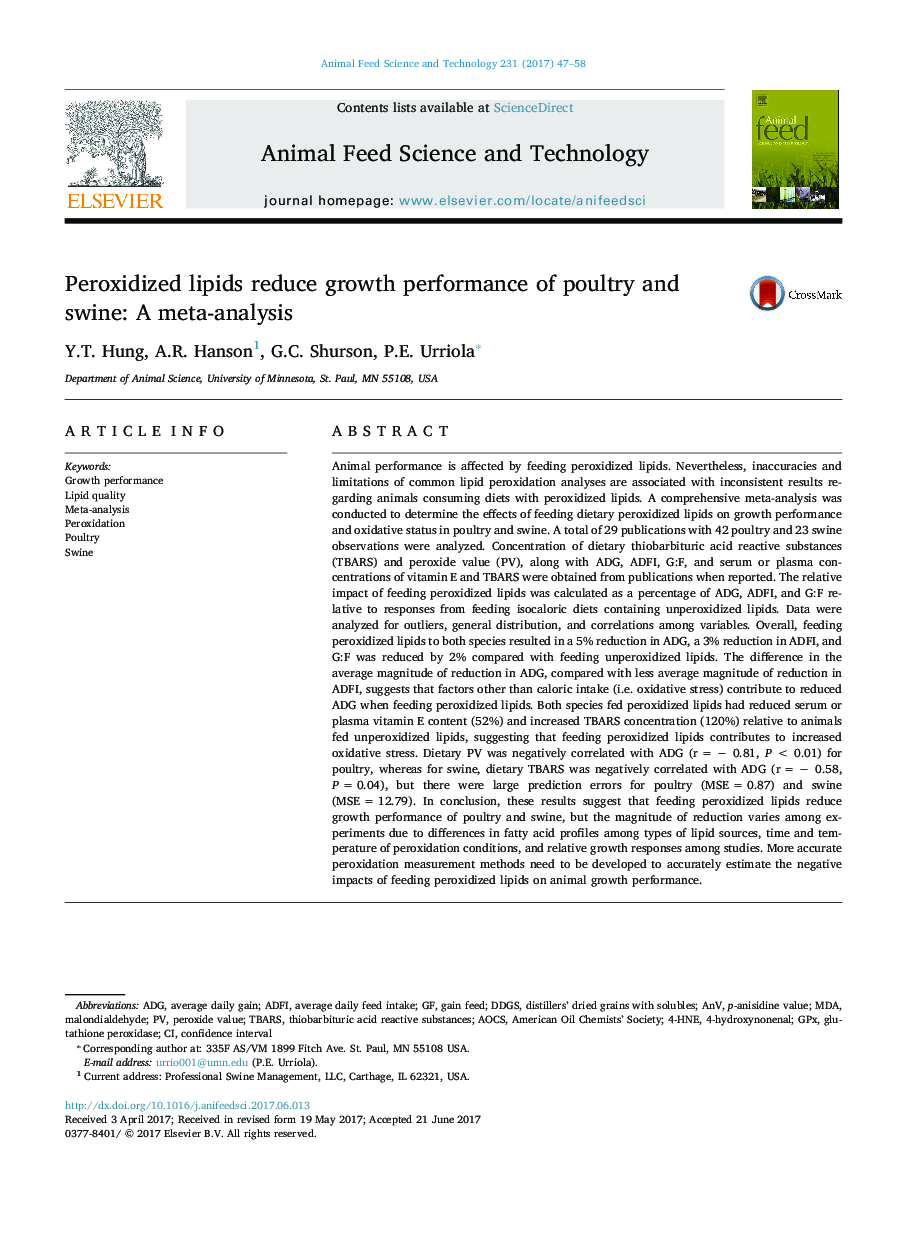| کد مقاله | کد نشریه | سال انتشار | مقاله انگلیسی | نسخه تمام متن |
|---|---|---|---|---|
| 5538807 | 1552355 | 2017 | 12 صفحه PDF | دانلود رایگان |
- Lipid peroxidation decreased growth of poultry and swine (5 and 9%) as consequence of decrease in feed intake (3 and 4%) and feed efficiency (3%).
- The decrease in growth was linear and there appears to be no tolerance level to dietary intake of PV or TBARS.
- Peroxide value is associated with decrease in growth in poultry and TBARS in swine, but neither are accurate.
Animal performance is affected by feeding peroxidized lipids. Nevertheless, inaccuracies and limitations of common lipid peroxidation analyses are associated with inconsistent results regarding animals consuming diets with peroxidized lipids. A comprehensive meta-analysis was conducted to determine the effects of feeding dietary peroxidized lipids on growth performance and oxidative status in poultry and swine. A total of 29 publications with 42 poultry and 23 swine observations were analyzed. Concentration of dietary thiobarbituric acid reactive substances (TBARS) and peroxide value (PV), along with ADG, ADFI, G:F, and serum or plasma concentrations of vitamin E and TBARS were obtained from publications when reported. The relative impact of feeding peroxidized lipids was calculated as a percentage of ADG, ADFI, and G:F relative to responses from feeding isocaloric diets containing unperoxidized lipids. Data were analyzed for outliers, general distribution, and correlations among variables. Overall, feeding peroxidized lipids to both species resulted in a 5% reduction in ADG, a 3% reduction in ADFI, and G:F was reduced by 2% compared with feeding unperoxidized lipids. The difference in the average magnitude of reduction in ADG, compared with less average magnitude of reduction in ADFI, suggests that factors other than caloric intake (i.e. oxidative stress) contribute to reduced ADG when feeding peroxidized lipids. Both species fed peroxidized lipids had reduced serum or plasma vitamin E content (52%) and increased TBARS concentration (120%) relative to animals fed unperoxidized lipids, suggesting that feeding peroxidized lipids contributes to increased oxidative stress. Dietary PV was negatively correlated with ADG (r = â 0.81, P < 0.01) for poultry, whereas for swine, dietary TBARS was negatively correlated with ADG (r = â 0.58, P = 0.04), but there were large prediction errors for poultry (MSE = 0.87) and swine (MSE = 12.79). In conclusion, these results suggest that feeding peroxidized lipids reduce growth performance of poultry and swine, but the magnitude of reduction varies among experiments due to differences in fatty acid profiles among types of lipid sources, time and temperature of peroxidation conditions, and relative growth responses among studies. More accurate peroxidation measurement methods need to be developed to accurately estimate the negative impacts of feeding peroxidized lipids on animal growth performance.
Journal: Animal Feed Science and Technology - Volume 231, September 2017, Pages 47-58
